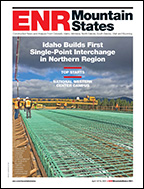
Ultimately, eight years of planning all came down to eight hours and about 700 ft—the distance traveled by a nearly 400-ft-long, 4.3-million-lb railroad truss on four self-propelled modular transporters, or SPMTs, during the last Saturday of August in Chicago.
The commuter-rail truss installation, believed to be the largest of its kind ever moved by SPMTs, is a key part of an approximately $102-million, three-level grade-separation contract held by Walsh Construction.
"We started erecting the truss in April and began jacking it up 25 feet the last week in July," says Curtis Luecke, Walsh project manager. "We decided the truss would be erected so that its floor was only six feet off the ground, for a safer elevation. That required us to engineer some footings that we constructed and buried. After the truss was finished, we excavated those footings and used them to jack the truss up."
With SPMT provider Sarens and its subsidiary Rigging International, crews rolled the 394-ft-long, 43-ft-wide, 67-ft- tall truss about 300 ft on Friday evening. That night, an existing roadway was shut down, and Norfolk Southern (NS) crews took down signals on the tracks. The next morning, the truss traveled east about 500 ft, pivoted north another 200 ft and then was lowered about six inches into its final position. Bearings were already attached to the truss, says Luecke.
"It took us about two hours to move the truss into place and two hours to fine-tune the locations of the bearings," he says. "The next step is to install the ballast, ties and rail, then demolish the existing bridge sometime in November."
The truss move is part of a larger job to increase access and enable expansion for a Ford plant, says Soliman Khudeira, Chicago Dept. of Transportation project manager. The plan is to realign three roadways and build new links below and above the NS tracks; it will require 9,000 linear ft of retaining walls, major utility relocations and six new bridges.
"One is this commuter-rail bridge," Khudeira says of the truss. "The other two are for Norfolk Southern. The three roadways will connect into one single intersection." The NS tracks will remain at grade, while the roadways dip 30 ft underneath. A highway bridge will connect to the Ford plant; the other two are footbridges. Walsh will next relocate the NS track alignment by fall 2013, says Luecke.
The project, slated for a 2015 completion, is part of the $3.2-billion, 72-project Chicago Region Environmental and Transportation Efficiency (CREATE) program that aims to relieve the crippling congestion of freight and passenger rail traffic.
But "this project was planned well before CREATE," says Kevin Fitzpatrick, executive vice president with Alfred Benesch & Co., the design and construction-services manager. Final design began in 2003, adds Benesch design manager Diane Campione. A plan to put the truss on temporary shoring towers over existing roads and tracks was stymied when NS failed to grant long-enough shutdown windows affecting some 50 trains a day.
Benesch and Walsh were involved in an SPMT roll-in on the $200-million Wacker Drive project. "This truss is four times bigger and 10 times heavier, but we wondered if we could do something like that," she says. After a presentation to NS, "they agreed to an eight-hour window," she recalls.
Walsh received seven bids for the SPMT subcontract. Sarens offered a plan for moving the truss without any tight connections required. "We didn't want to wrap chains around the bottom chord of the truss" for fear of damage, Luecke says.
The high-strength steel-truss design was revamped to eliminate skew, says Campione. "That meant more structural pieces of similar length and squared-up abutments," she says.
The truss move, completed well within the allotted eight-hour window, saved $12,500 an hour in liquidated damages, says Khudeira. The installation took half the time that would have been required using falsework, "not to mention the hundreds of thousands of dollars in additional labor and railroad flagmen costs," says Fitzpatrick.



